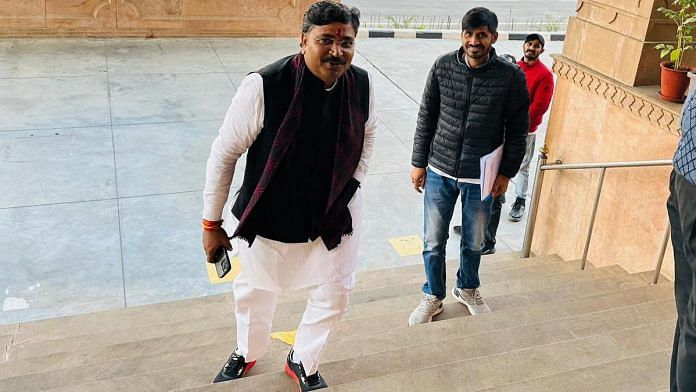Earlier this month, the All-India Congress Committee made two significant appointments in Rajasthan. Tika Ram Jully, a three-time MLA from Alwar Rural, was chosen as the Leader of the Opposition in the Rajasthan assembly, marking the first time a Dalit leader has held this position in the state. In the same notice, Govind Singh Dotasra, a Jat leader, was reappointed as the president of the Rajasthan Congress.
Dotasra also held the state Congress presidency before the state elections, while Jully was cabinet minister for social justice & empowerment in the former Ashok Gehlot-led government.
The positions given to Jully and Dotasra are crucial in state politics as far as the opposition is concerned. The state party president plays a central organisational role, while the Leader of the Opposition is the primary voice of dissent against the state government in the assembly.
The selection of Jully and Dotasra seems to be a strategic manoeuvre by the Congress to strengthen its Jat-Dalit support base in Rajasthan. The Dalit community comprises 18 per cent of the state’s population, while the Jats make up about 10 per cent.
Although the Jat-Dalit combination of Chandrashekhar Azad and Hanuman Beniwal did not prove successful in this election, it holds potential for the Congress in the future, not just in Rajasthan but also in other states where these communities have electoral heft.
Also Read: BJP’s social engineering in Rajasthan — why the party chose Bhajanlal Sharma as CM
Congress’s Dalit advantage in Rajasthan
Making a Dalit MLA the Leader of the Opposition is not just a strategic move by the Congress, but also reflects a political compulsion. After securing power in Rajasthan last month, the BJP appointed Bhajanlal Sharma, a Brahmin, as Chief Minister. To balance out the caste equation, it designated two Deputy Chief Ministers—Diya Kumari, a Rajput, and Prem Chand Bairwa, a Dalit.
Further, in May 2023, the BJP appointed Arjun Ram Meghwal, a Dalit MP from Rajasthan, as Union minister of state for law. After BR Ambedkar, he is only the second Dalit leader in India to become law minister.
Given this backdrop, Congress making Jully the Leader of Opposition in the assembly indicates several things.
First, he serves as a counter to Bairwa. Both MLAs are relatively young Dalit faces (Bairwa is 54 and Jully is 43) and both are highly educated. Bairwa holds MA, LLB, MPhil, and PhD, while Jully is qualified in law. While Bairwa is a second-time MLA, Jully became a legislator for the third consecutive time. Significantly, CM Bhajanlal Sharma’s team predominantly comprises young faces. Consequently, Congress seems to not only be prioritising youth leadership but also considering the caste dynamics in its strategy.
Second, Congress appears wary of losing Dalit votes to the BJP especially given the elevation of Meghwal and Bairwa. The community has consistently voted for Congress, even when other sections of society turned away. It is critical for the Congress to retain this support and prevent it from shifting to other parties.
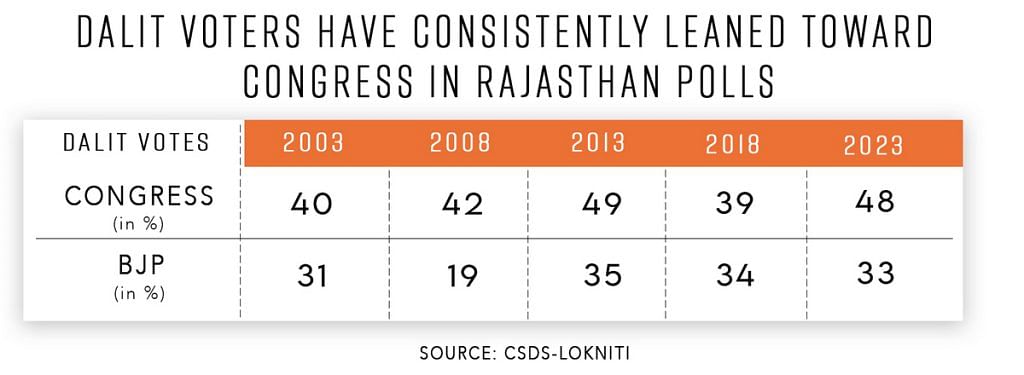
It’s worth noting that despite over 56,000 cases of atrocities against Dalits being registered during Gehlot’s tenure as CM, coupled with a dipping conviction rate, the community has remained loyal to the Congress. In fact, their support has increased, with 48 per cent of Dalits voting for the party in the last election compared to 39 per cent in 2018.
Finally, the Congress may be eyeing the opportunity to capitalise on the declining support base of the Bahujan Samaj Party (BSP). The Dalit-centric party, which once commanded an over 7 per cent vote share in Rajasthan, has been on a marked descent. Its vote share fell from 4 per cent in 2018 to about 1.8 per cent in 2023.
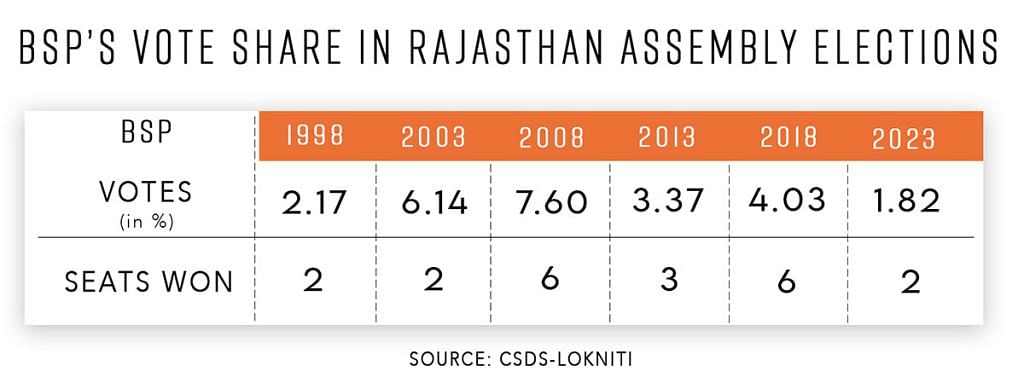
Jat factor
The Congress has been casting a watchful eye on the Jat community, which has been upset with the BJP-led central government over multiple issues. Over the last few years, Jats have been at the forefront of several agitations, including over the three farm laws (since repealed) and the wrestlers’ protests against sexual harassment. With their substantial presence in Rajasthan, Haryana, Punjab, Delhi, West UP, and some parts of Madhya Pradesh, Jat voters significantly influence election outcomes.
In Rajasthan, the demand for a Jat CM has simmered for years, and the community hoped BJP might finally fulfill it this time. Satish Punia, the state BJP president and former deputy speaker of the Rajasthan assembly, seemed a potential candidate, but their hopes were dashed when the BJP chose Sharma.
Previously, the community, traditionally Congress voters, moved away from the party for similar reasons. Now that things have come full circle yet again, the decision of the Congress to reappoint Govind Singh Dotsara as its state president could be seen as an overture toward the Jat community.
While the community has given 30-40 per cent of its mandate to the Congress since 2003, this time it reportedly gave the party only a fifth of its votes. Instead, Jat voters leaned more towards the BJP, with one-third of them supporting the party in hopes of a Jat CM coming to the helm. Looking ahead to the next assembly election, it is conceivable that Jat voters might polarise against Bhajanlal Sharma in anticipation of a Jat CM from the Congress.
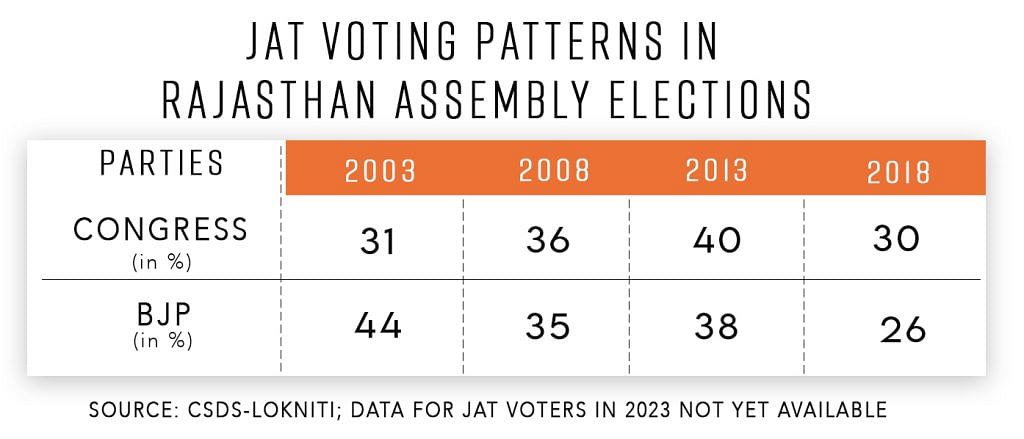
Also Read: Kharge as INDIA bloc’s PM candidate kills 2 birds with 1 stone for Mamata and Kejriwal
Leveraging the Dalit-Jat combo
In the 2023 Rajasthan assembly elections, the BJP won 115 out of the total 200 seats, while the Congress managed only 69. Despite this, the Congress clinched 39.5 per cent of the vote share—just 2.2 percentage points less than the BJP’s 41.7 per cent.
In such a situation, covering this 2 per cent gap through the Dalit-Jat combination could be a good strategy for the Congress.
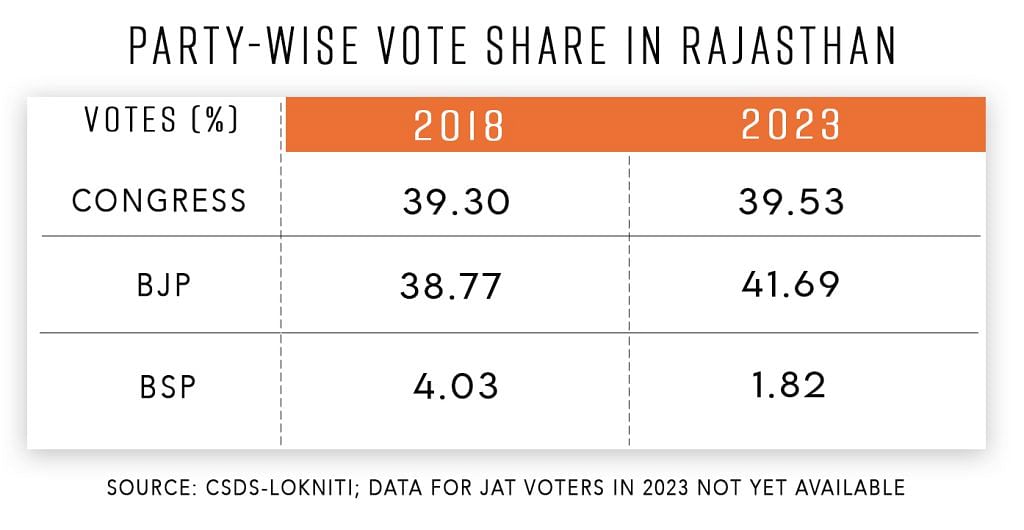
In the 2023 Rajasthan polls, two other parties attempted to leverage this combination: Dalit leader Chandra Shekhar Aazad’s Azaad Samaj Party and Jat veteran Hanuman Beniwal’s Rashtriya Loktantrik Party (RLP). The two formed an alliance, aiming to challenge both the BJP and Congress, with reports suggesting they could influence outcomes in up to 40 seats.
In 2018, Beniwal retained his seat and two other RLP candidates secured victories in Scheduled Caste reserved seats. But this time only Beniwal emerged victorious. RLP’s vote share remained almost the same—2.39 per cent, marginally less than 2.4 per cent in 2018. Aazad’s party failed to secure any seats, although it did come second in two.
The alliance’s failure can be attributed to several factors, including Azad’s lack of credibility in Rajasthan due to his party’s poor performance in the 2022 UP assembly elections. While people came in large numbers to his rallies and protests, this did not translate to votes. Secondly, the election in Rajasthan was a direct battle between Congress and BJP.
So, what next? To strengthen the Dalit-Jat combination in Rajasthan’s politics, the Congress could unite Hanuman Beniwal and Chandrashekhar Aazad under the INDIA bloc. This move could pave the way for a Congress comeback in Rajasthan, with possible ripple effects beyond its borders in states like UP, Haryana, and Punjab that have significant Jat and Dalit populations.
Krishna Mohan Lal is a PhD research scholar at Tata Institute of Social Sciences, Mumbai. He tweets @Maitreya_G. Views are personal
(Edited by Asavari Singh)


